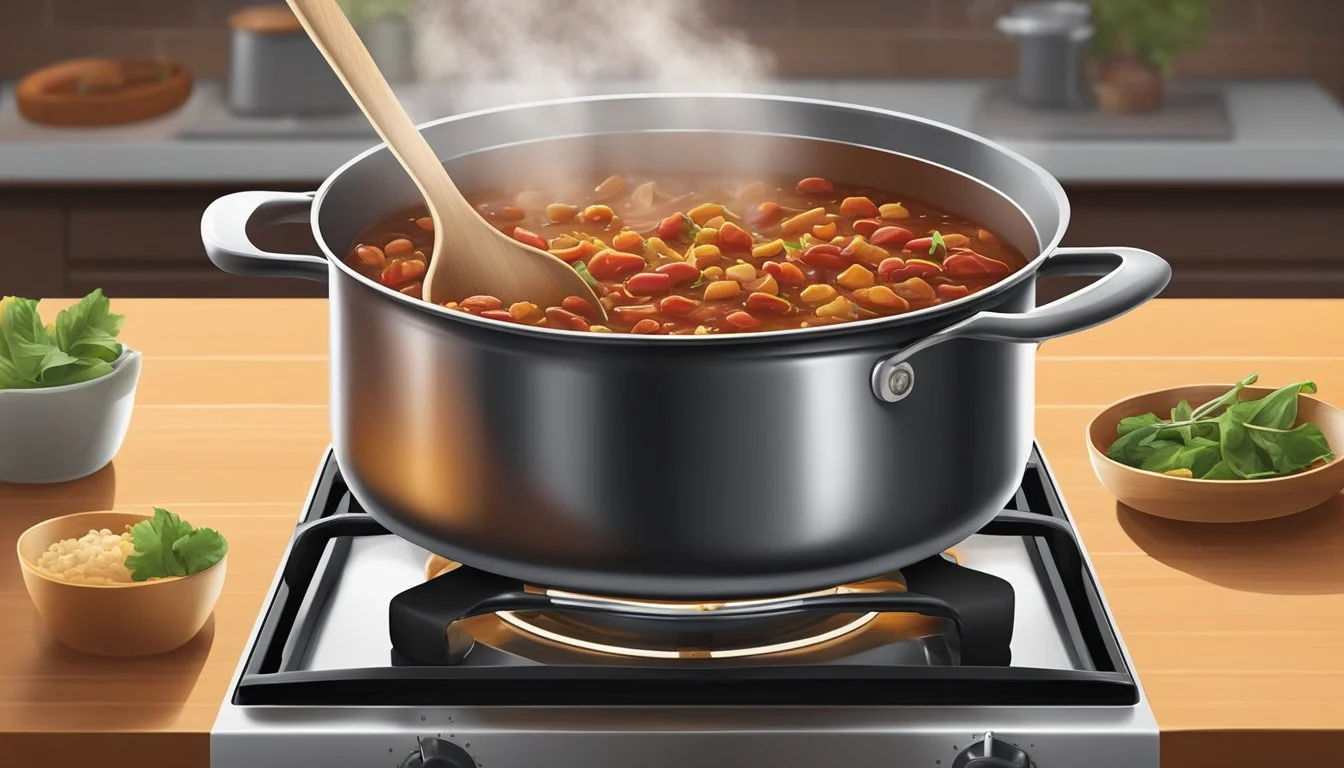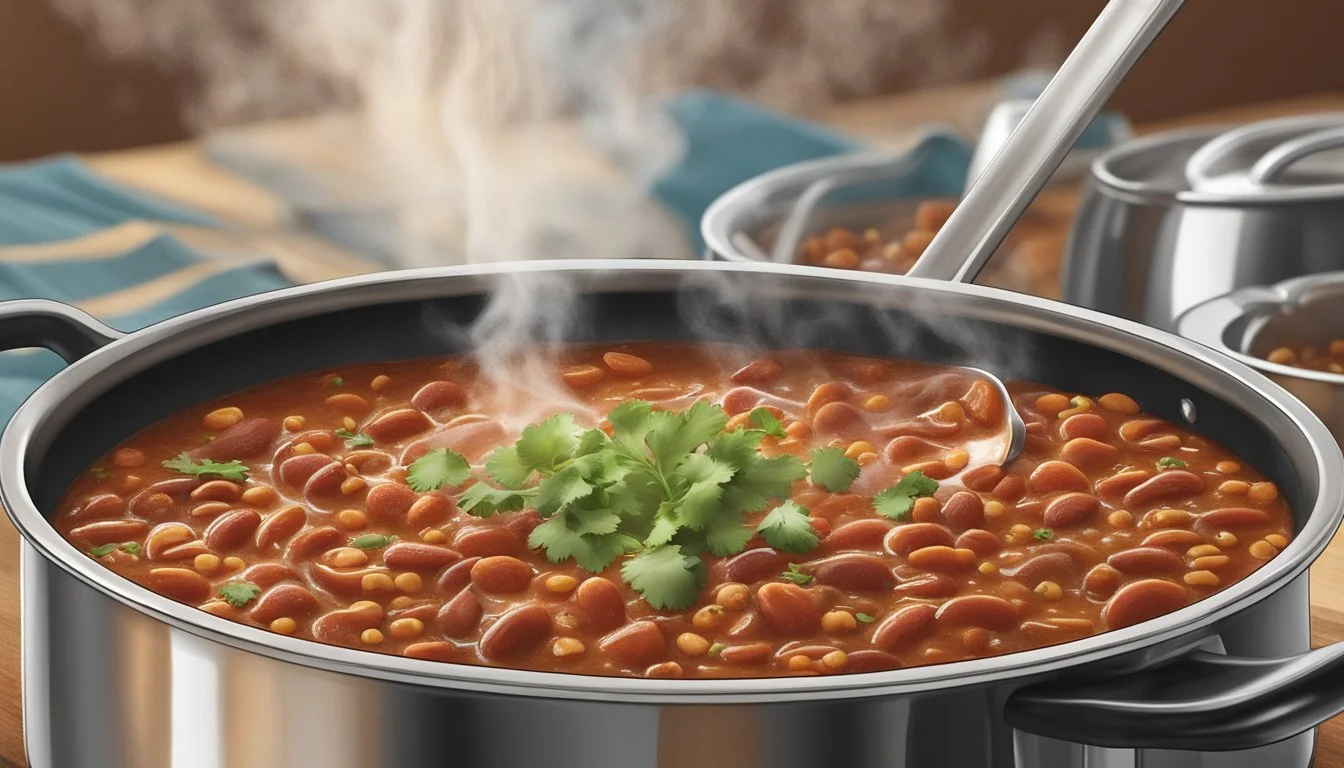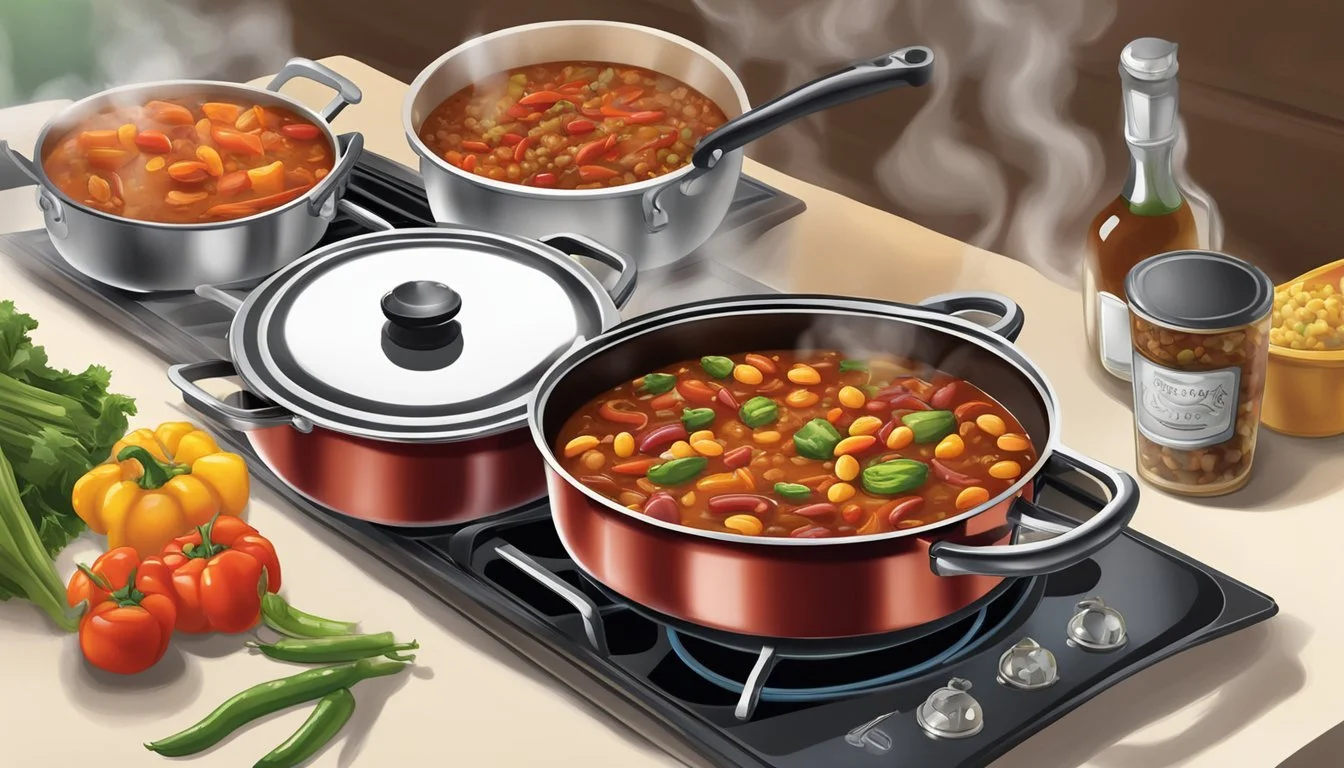Best Way to Reheat Turkey Chili
Tips for Preserving Its Hearty Flavor
Reheating turkey chili without compromising its heartiness and flavor requires a careful approach. Turkey chili is a comfort food favorite that combines the richness of ground or diced turkey with a medley of spices, beans, and vegetables. The challenge when reheating lies in maintaining the dish's moisture, ensuring the protein stays tender, and preserving the nuanced flavors developed during the initial cooking process.
One successful method involves gently warming the chili on the stove. This control allows for even heat distribution and prevents overcooking. To enhance the flavors further, it may be beneficial to add a splash of broth or water as needed during the reheating process. The liquid helps to loosen the chili and bring back the fresh taste it had when first prepared, while constant stirring ensures that the chili heats through evenly without sticking or burning.
It is also essential to be mindful of food safety when reheating any dish, including turkey chili. The chili should be heated to an internal temperature of 165°F to ensure it is safe for consumption. Using a food thermometer can confirm when the chili has reached this temperature. By following these guiding principles, one can restore the robust flavors and textures of the original dish, making leftover turkey chili just as enjoyable as when it was first served.
Understanding Turkey Chili
Turkey chili offers a rich tapestry of flavors and textures that make it an excellent choice for a hearty and nutritious meal. It combines lean protein, a variety of vegetables, and a blend of spices that contribute both to its health benefits and its satisfying taste profile.
What Makes Turkey Chili a Hearty and Flavorful Meal
Turkey chili is a robust concoction that appeals to those seeking both nutrition and taste. The ground turkey serves as a high-protein, low-fat alternative to beef, which is often traditionally used in chili. Beans, typically kidney beans, further enhance the chili by adding fiber and additional protein, while also lending a satisfying texture.
The layers of flavor in turkey chili are built with a mélange of vegetables like onions, bell peppers, and garlic, which contribute essential nutrients, as well as diced tomatoes that provide a tangy foundation to the dish. The spice profile, often consisting of chili powder and cumin, not only adds depth to the flavor but also offers various health benefits and antioxidants.
Turkey Chili Ingredients:
Protein: Ground turkey
Vegetables: Onion, bell pepper, garlic, diced tomatoes
Beans: Kidney beans (or alternative beans for variety)
Spices: Chili powder, cumin
The Role of Key Ingredients
Each ingredient in turkey chili plays a vital role in ensuring the meal is both nutritious and delicious. Ground turkey is a lean source of protein that is lower in calories and saturated fat than many other meats, supporting a healthy diet. Beans not only contribute to the heartiness but are also a source of complex carbohydrates. They help regulate blood sugar levels and provide sustained energy.
Onions and bell peppers add not only natural sweetness and crunch but are also packed with vitamins and minerals. Garlic, besides being flavorful, has been recognized for its health benefits, including its potential to boost immunity.
Spices, predominantly chili powder and cumin, are decisive in defining the character of the chili. Chili powder provides a smoky warmth, while cumin offers its distinctive earthy note. Together, these spices underscore the essence of chili and can be adjusted according to taste, making the dish easily adaptable to different palates.
By understanding each component that makes up turkey chili, individuals can better appreciate the balance of taste and nutrition it offers, as well as the importance of heating it properly to maintain its distinct flavors and textures.
Preparation Before Reheating
Proper storage and careful thawing are essential steps to ensure the turkey chili's hearty flavor and texture are retained when reheating.
Storing Turkey Chili Properly
To preserve the quality of turkey chili leftovers, it is crucial to store them in an airtight container. This not only helps retain moisture but also maintains flavor by preventing the absorption of other odors in the refrigerator. Leftovers should be stored within two hours of cooking to prevent bacterial growth. For refrigerator storage, use within three to four days. If the chili will not be eaten within this time frame, it should be placed in the freezer where it can last for up to six months.
Thawing Frozen Turkey Chili
When one needs to thaw frozen turkey chili, they should plan ahead. Transferring the chili from the freezer to the refrigerator is the safest method, allowing it to thaw gradually — typically overnight. If one is short on time, they may use the microwave's defrost setting, but they should ensure even thawing to avoid any hot spots which might overcook certain areas while others remain frozen. Thawing at room temperature is not recommended, as it can lead to bacterial growth.
Reheating Methods
Proper reheating of turkey chili is crucial to preserve its heartiness and flavor. One can employ various methods––stovetop, slow cooker or Dutch oven, and microwave or oven.
Stovetop Reheating Instructions
To reheat turkey chili on the stovetop, one should place the chili in a pot on the stove over low to medium heat. This method allows them to stir occasionally, ensuring even distribution of heat and preventing the chili from sticking. It's best to maintain a gentle simmer and avoid boiling to keep the turkey chili from drying out.
Using a Slow Cooker or Dutch Oven
To warm turkey chili using a slow cooker, set it on the low heat setting for a gradual and thorough reheating process. For a Dutch oven, the chili is placed in the pot, with the oven preheated to a low temperature around 325°F. The chili should be stirred occasionally and can be covered to retain moisture.
Utilizing Microwave and Oven
Microwave reheating is quick and convenient: turkey chili should be placed in a microwave-safe dish and heated in short intervals, stirring between each to achieve even warming. Using an oven involves preheating to 350°F and transferring the chili to an ovenproof dish. One can add a touch of water or broth to prevent dryness, covering the dish with foil or a lid, and heating until the chili reaches the desired temperature.
Maintaining Quality and Safety
When reheating a healthy turkey chili, it's crucial to use the proper temperatures to preserve its texture and flavor while ensuring it's safe to consume. Safeguards against contamination during storage and reheating are also vital for food safety.
Optimal Reheating Temperatures
Turkey chili, as a type of stew or soup containing meat and broth, should be heated to an internal temperature of 165°F (74°C). This temperature eliminates harmful bacteria and ensures that the meal is safe for consumption. The reheating should be done slowly and evenly, which allows the flavors to meld without compromising the chili's integrity. An oven set to a moderate 325°F to 350°F is ideal for reheating. This process generally takes about 20-30 minutes for individual servings or up to 45 minutes for larger batches. To prevent the drying out of the chili, it should be placed in an oven-safe container, covered with a lid or aluminum foil, which helps to retain moisture during reheating.
Preventing Contamination
Proper storage and handling are key to preventing foodborne illness. Healthy turkey chili should be stored in an airtight container to protect it from external bacteria. In the refrigerator, turkey chili should be stored at or below 40°F (4°C) and consumed within 3-4 days to ensure safety and to keep quality intact. Prior to reheating, make sure that all utensils and surfaces have been cleaned adequately to avoid any cross-contamination. If the chili has been frozen, it should be thawed in the refrigerator and not at room temperature to keep bacteria growth in check.
Enhancing the Flavor
When reheating turkey chili, one must not only focus on temperature but also on flavor integrity. Ensuring the chili remains delicious and flavorful while maintaining the balance of seasonings is crucial.
Adjusting Seasonings
To maintain a hearty flavor profile, they may need to adjust the seasoning after reheating. Turkey chili can lose some of its robustness, and a taste test is vital:
Salt and Pepper: A pinch or two can revive the chili's core flavors.
Cayenne Pepper: For a kick of heat, a small amount goes a long way.
Paprika: It not only adds a smoky dimension but also enhances the chili's color.
They should introduce seasonings gradually, stirring and tasting to avoid overpowering the dish.
Adding Fresh Ingredients
Introducing fresh ingredients can greatly enhance the overall taste:
Oregano: Fresh, chopped oregano or a sprinkle of dried oregano can brighten the flavor.
Finely diced bell pepper or onion added during reheating can reintroduce a crunch and freshness.
Their goal is to complement pre-existing flavors without shifting the flavor profile of the chili drastically. Calculated additions can make the difference between a standard reheated bowl and an aromatic, memorable meal.
Serving Suggestions
When reheating turkey chili, topping it with the right ingredients and choosing the perfect side dishes can greatly enhance its flavors and make it more enjoyable. Here’s how one can elevate a simple bowl of reheated turkey chili with thoughtful serving suggestions.
Choosing Complementing Toppings
The right toppings can transform the turkey chili experience by adding a variety of textures and flavors.
Cheese: Shredded cheddar cheese is a classic choice that melts perfectly into the hot chili. However, one could also explore other shredded cheeses for a different taste profile.
Sour Cream: A dollop of sour cream can introduce a creamy tanginess that balances the chili’s hearty nature.
Avocado: Diced avocado provides a smooth, buttery texture and a rich, subtle flavor that pairs well with the spices in the chili.
Cilantro and Green Onions: Fresh cilantro and chopped green onions add a burst of color and a refreshing taste that cuts through the richness of the dish.
Crunchy Elements: Tortilla chips or strips provide a delightful crunch and are perfect for scooping up the chili.
A table listing popular toppings:
Topping Description Texture/Flavor Cheddar Cheese Melts well for added richness. Creamy/Cheesy Sour Cream Offers a cooling contrast. Creamy/Tangy Avocado Adds a buttery and smooth element. Rich/Buttery Cilantro Provides a fresh, herbaceous note. Aromatic/Fresh Green Onions Gives a mild, oniony bite. Crisp/Mild Tortilla Chips Perfect for added crunch and scooping. Crunchy/Salty
Pairings and Side Dishes
Side dishes can contribute to a well-rounded meal and enhance the overall dining experience of turkey chili.
Cornbread: Slightly sweet, soft cornbread complements the spicy and savory notes of turkey chili.
Salad: A light, crisp green salad provides a refreshing contrast to the hearty chili.
Rice: For those seeking a more filling option, rice makes an excellent base that absorbs the chili flavors.
Below is a brief list of side dish pairings:
Cornbread: A sweet and tender partner for the robust chili.
Salad: A crisp and green side that refreshes the palate.
Rice: A subtle and hearty base that complements the chili's richness.
By selecting the right toppings and side dishes, one can easily enhance the reheated turkey chili and turn it into a more enjoyable and satisfying meal.
Alternative Chili Variations
When it comes to chili, beef and chicken are popular bases, but vegetarian and vegan versions are also hearty alternatives that cater to different dietary preferences.
Beef Chili and White Chicken Chili
Base: Typically uses ground beef as the main protein.
Broth: Beef broth adds depth of flavor.
Texture: The beef lends a rich and hearty texture to the dish.
White Chicken Chili:
Protein: Utilizes chicken, often pulled or diced.
Base: Often made with chicken broth for a lighter flavor profile.
Color: White beans contribute to the pale color and creamy texture.
Vegetarian and Vegan Options
Protein: Beans, lentils, or quinoa can serve as hearty substitutes for meat.
Dairy: May include cheese or sour cream as toppings, which can be omitted for a vegan version.
Vegan Chili:
Ingredients: Excludes all animal products, relying on vegetables, beans, and plant-based proteins.
Broth: Vegetable broth is used in place of meat-based broths.
Safe Storage and Future Meal Prep
To ensure the quality and safety of your turkey chili, attention to storage and meal prep is essential. Not only does proper storage prevent spoilage, but it also maintains the flavors for future meals.
Tips for Freezing Leftover Chili
Storing Leftovers: Cool the turkey chili completely before storing. Then, place it in an airtight container or freezer bag to prevent freezer burn and flavor loss.
Freezing: Label the container with the date and contents. Turkey chili can be safely frozen for 2-3 months. When ready to reheat, thaw in the refrigerator overnight to preserve the texture and flavors.
Meal Planning with Reheated Turkey Chili
Meal Prep Efficiency: Allocate portions of turkey chili for the week's meals by storing them in separate containers in the fridge for a convenient grab-and-go option. They will remain fresh for 3-4 days.
Reheating Tips: Choose the stove or oven for reheating to best retain the chili's heartiness and flavor. If frozen, ensure that the chili is thoroughly thawed in the fridge prior to reheating.
Conclusion
Reheating turkey chili effectively requires attention to detail to preserve its textures and flavors. Below are key takeaways for optimal reheating:
Temperature Control: A moderate oven temperature of 325°F to 350°F is effective for reheating without causing the chili to dry out or burn.
Added Liquids: To maintain moisture, a tablespoon of water or stock per portion can be helpful.
Cover to Retain Heat: Covering the chili with foil or a proper lid prevents moisture loss and ensures even heating.
Heating times may vary depending on the portion size; small quantities may need approximately 15 minutes, while larger amounts could require up to 45 minutes. It’s important to ensure turkey chili reaches a safe internal temperature.
They should use a food thermometer to check that the chili has reached 165°F to ensure it is thoroughly heated and safe to eat.
By following these guidelines, one can enjoy a warm, hearty, and flavorful dish that tastes as though it was freshly made.






